Suddenly, Jim Cummings was afraid of getting into a car accident. Although the writer/director seems utterly fearless now, attracting thousands of fans on Twitter by imploring them to make their movie against all odds as he would eventually do, it was nearing the first day of shooting his debut feature “Thunder Road” when panic set in that some act of God would get in the way of fulfilling his filmmaking destiny after overcoming every other roadblock imaginable to the production start date. Although he’s built an army of believers in the time since making the short that inspired the feature, he’s developed a mantra that “the cavalry’s not coming,” an ethos that led him to drive well below the speed limit as the big day approached, knowing that if he wasn’t around to make this movie, nobody else would.
As a result, “Thunder Road” is a singular film and it’s fitting that as single-minded as Cummings was in the time leading up to “Thunder Road,” he plays a man possessed in front of the camera as well, slipping into the skin of Officer Jim Arnaud, who always appears as if he wants to crawl out of it following his mother’s death, not only grieving a loved one but facing an uncertain future after his wife (Jocelyn DeBoer) has left him with their young daughter Crystal (Kendal Farr) in tow. While Cummings built the short around the catharsis of dancing awkwardly in uniform to Bruce Springsteen’s “Thunder Road” after laying his mother to rest, with the desperation of a passionate man who had trouble expressing himself becoming both troubling and endearing, the feature amplifies those emotions as if Officer Arnaud found an extra volume setting on his boombox, becoming a danger to himself and others as he continues to serve as active law enforcement while recklessly attempting to reclaim custody of his daughter and be the best father he can to her.
A true force of nature, you can’t take your eyes of Cummings as Officer Arnaud, but as a filmmaker, there’s plenty of temptation to draw your attention away with the film’s sumptuous music, its immersive long takes and its impressive ensemble cast. Yet it’s all of a piece for which the overwhelming feeling that emerges is love, between how much Officer Arnaud has for Crystal and how much of it has been poured into every detail by its director to create the cinematic equivalent of a bear hug. It’s a truly spectacular film that has finally started making its way across the country theatrically after premiering earlier this year at SXSW, where it won the Grand Jury Prize for Best Narrative Feature, followed by similar honors at Seattle and Nashville, and in the midst of a busy release, Cummings spoke about why adapting his short to a feature was by no means a certainty, assembling a crew as excited to make the movie as he was and balancing his responsibilities behind the camera with those in front of it.
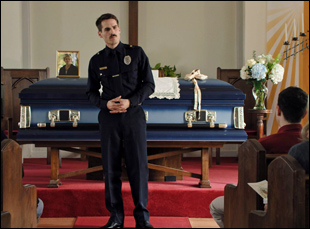
For a long time, I said that it couldn’t be a feature. I thought, “No, that’s the most interesting moment of that guy’s life. Anything else is just going to be filler.” In my mind for a long time, that was the climax because the whole lead up to that would be his relationship with his mom and then she passes away and then [you see this moment at the funeral], and I thought that’s terrible. But I was watching the short again in December of 2016, and I hadn’t seen it in months, and there’s that moment where my daughter pulls away from me on the back pew. I was thinking a lot about screenplay format and there’s a lot [of emphasis] about inciting incident that’s supposed to happen on page 10 of a screenplay and it’s supposed to be this thing that launches the hero [into the story] and then I thought, “Oh shit, what if this is the opening of the movie?” And if that’s the opening, the movie has to be about this dad trying to be a dad trying to raise his daughter — it has to be about parenting rather than being about the son of a mother. So I thought about it for a while and I had already been thinking a lot about Springsteen and America and leaving your small town and going to make something of yourself and not putting up with the bullshit — you know, American stuff, and it came very quickly.
I always say it happened over a long time and then all at once, but it really did. I actually went into A24 with the idea, and said, “Hey, this is the feature. This is my pitch,” and it was just one of the scouts that I know [there] who’s really lovely, and he said, “Yeah, we usually only buy scripts. Write the script.” So they encouraged me to write it and I went to my buddy’s basement and I stayed up until 6 a.m. for a couple days, writing this script and by the end of the three days, I had like 50 pages written. It was still the first draft, but I had something and then [A24] won the Oscar for “Moonlight” and I’m like, “I’m never going to talk to these guys ever again.They’re never going to call me back.” [laughs] And I didn’t even try. I said, “Hey, I know you guys are busy,” and then I sent it to Zack Parker, a buddy of mine who loved the [short] and he was at AMC at the time, and he said, ‘I want to leave and make three feature films and I want this to be the first one.” I said, “You’ve never done a feature before” and he said, “Hear me out.” And he brought me out to lunch and we talked about it and by the end of the lunch, we were both crying. He had good ideas and I don’t think I would’ve made it had he not encouraged me to do it. He’s just like, “Let’s just go and make the thing.” So we ran a Kickstarter campaign and it was a really weird way of going from short to feature, but now we do everything. It went from being a short film to now [having] this production studio where we have movies and a slate [of movies] now.
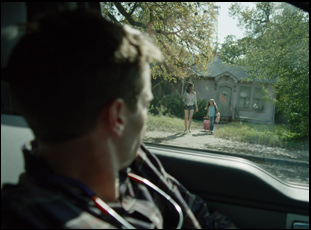
I was very lucky. I had four or five producers on this film and Danny [Madden], one of my best friends and also a filmmaker, became the creative director of the film, which meant that he’d sit behind monitor and if it went out of focus and we knew it wasn’t going to work, he was the one who’d shout “cut.” So that was great to have many eyes on the monitor while I was jumping in front of it. But the way that I direct while acting is I know exactly everything needs to be in the frame at all times. We’ve already had all these production meetings about what exactly is needed [for each scene]. It doesn’t need to be a police station. It just needs to be a wall with a blue line on it because that is what the frame is going to be, so all of that stuff we shot in warehouses rather than shooting in police stations because I was a producer for eight years, [knowing] exactly what needed to be in the frame. [Directing] becomes a lot of me being this camp counselor running around and making sure everybody’s okay and happy and working well and fulfilled. I’d run around [asking], “Are we sure we’re getting everything? Cool? Cool. Alright, good.” And then I jump in frame and I put the acting hat on and get into character. It was a weird kind of do-si-do, but man it was fun.
When it’s a character like this that’s given to digressions, do you have the leeway as an actor to go where you want to go or is it all scripted?
It’s all extremely scripted. In long takes, it has to be. Every single moment is planned — every little stupid line, every seeming mess up – [where] the boombox not working — all of that’s planned. All of that is in the DNA of each scene. It has to be, otherwise the camera won’t be in focus or the camerawork won’t be right. We’re using a lot of dollies and zooms in the feature and it’s very complicated, but all of that is written out in the process of me writing it. It’s performed. I never really write when I’m writing. I stand up and I act out the scenes and then I write down the best improv and because of that, it feels it’s actually coming out of human vocal chords as opposed to a writer imagining it’s going to sound good when actors start speaking the lines.
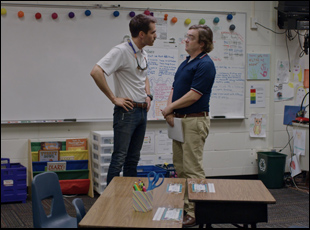
Because the movie’s a bunch of long takes, a lot of it you’re stuck with. There’s some performance enhancements in sound design and directing where the eye is going to be and [some] slight digital zooms, but really, you know it when you got it with these long takes and I just have to know what it has to be because I’m the director. There are times where I’m [on set] like, “Okay, we’re going to have the guy jump the fence and he’s going to slam into his ribs and then he falls down” and I catch myself saying “the guy” and I’m like, “Oh, that’s me. And we’re shooting that tomorrow.” So I’ll do this weird third person view of what needs to be in frame and then I do it.
It is weird to jump between in the editing room [figuring out] what to focus on and how much we’re staying on me and how much we show of my sister and when do we cut, but I also had good help in the editing room, like Brian Vannucci, who cut the movie for the three weeks [while] we were in Austin, and then coming back to L.A. and editing for another three months. We were showing cuts to people throughout, [which] was really helpful, like “Oh, that doesn’t work” or “this needs a better transition in sound” or “maybe there’s a different take here.” It was nice to be able to spend the time cutting it and then showing full cuts of the movie because we already had one by the second day after we wrapped. It’s all long takes, so it’s like legos. You drag the shots into place and that’s it.
Did you have the score in mind from the start? I was just blown away by it.
I knew that I wanted to have that field organ. That’s in the living room of my mom and dad’s house and I was playing around with it, doing these simple chords three weeks before shooting, and I was like, “This sounds really good.” So I recorded it in the voice memo app, and then I cut it on the plane to Austin, and I thought this could be really good for the movie, so then that became that song for the chase sequence and then I play a couple instruments [in the film] – I play the ukelele in the sad montage scene and the opening and then I knew I wanted to have a cello [too]. Then the harmonium sounds so much like a sad organ, [and the music] had to be funeral-based, so we knew that we wanted that, so it was in the DNA of the project. There wasn’t a whole lot of improv, but also, we didn’t really have a composer or compositions. We wanted the music to be its own thing.
Because you hit the ground running exposition-wise, you also rely on strong production design to speak to the characters’ lives before you meet them. What was it like figuring that out?
The production design was great. I’ve worked with Charlie Textor, the designer, on seven short films of mine and then the feature “13 Cameras” and he always has an answer, a plan, and something cool to make the movie a thousand times better than anything you could’ve thought of. He’s just a great guy and we brought on a couple of other [people] — our art director Joscelyne [Ponder] and our wardrobe Michaela [Beach] were incredible and local to Austin. It was a very scrappy team and the entire art department was two people basically and then whenever Danny had a free hand, he could go and help out. And with the production design, because it’s Austin and this is a middle class home, it’s never going to be anything too nice. Like there’s a scene where [Officer Arnaud] gets [his daughter] a new bed and that’s a big deal and I said, “Don’t worry about finding the perfect bed. Go to K-Mart and find the nicest bed.” And he was like, “Yeah, absolutely.” This is a guy who doesn’t stray far from the strip mall. You can’t. That’s the point. So everything in the movie was fielded locally, so it has that feel to it.
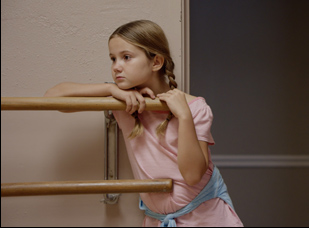
Kendal was an incredible find. We had a casting director named Vicky Boone, who’s based out of Austin and cast “Tree of Life” [among] other movies, and she’s really lovely and sent us a bunch of tapes. Out of the 50 or 60 submissions, we probably brought in 10 girls to come in and play Crystal and there were moments with others and they were all great, but Kendal felt like my daughter. That’s a weird thing to say, but she and I had such a cameraderie off-camera, like whenever we weren’t filming, she was climbing on my back and goofing around. We just liked each other and she’s obviously a very talented actress. She was instantly able to go into character right before we started shooting and was just very thoughtful and wise beyond her age. That’s what we needed. Working with kids, you don’t know whether they’ll have too much blood sugar and they’re going to crash soon. She wasn’t like that. She felt like one of the team and was empathetic and funny and willing — and able — to do the long takes that were poignant and funny and sad. Her pacing was great. It was just luck that we found her and I’m glad that we did.
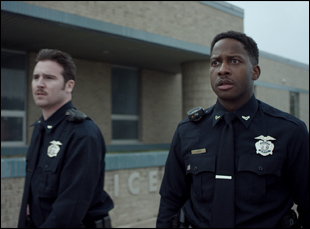
Nican and I were friends on Instagram — that’s how I found Nican. He was at the Sundance Resort for a theater program and for whatever reason, I was looking at that location and there was a picture of people and I clicked on this one dude. He’s a comedian as well and I was just laughing at some of his videos and he either messaged me or I messaged him. This is probably six months before we started shooting, and he had just moved from Oakland to L.A. And he said, “We should grab a beer,” and very quickly, we just became friends. I [told him about “Thunder Road,” saying], “Hey, I think you should come and audition.” And he said, “I’d love to.” So he read the whole script and then sent audition tapes in and we shot this little screen test of the scene of him in the doorway where he comes to make sure I’m okay. He was just great, but then we cast somebody else — a celebrity — and it ended up not working out.
So eight hours before we were shooting [with that character], we had to bring in Nican and the whole time, even though he knew he wasn’t cast in the movie, he was still filming having people film him on an iPhone, writing monologues and sending them to me, like “Hey man, this is an interesting thing if the other actor…” so he was the perfect understudy. [When the other actor couldn’t make it] I called him and said, “Hey, man, I don’t think this other thing is going to work out. What are you doing?” And he’s like, “I’m returning a T-shirt to Target.” And I said, “Yeah, can you get on a plane soon and come to Austin? I think I need you to play this part.” And [without hesitation] he was like, “Yep, I’m on my way.” Very quickly, he came on and he was phenomenal. I think this might be one of his first features and I love all of his scenes. He makes them so great and now he comes and hangs out [with me] all the time. It’s funny. You can’t help but become good friends with people, just in making movies.
“Thunder Road” opens on October 19th in Los Angeles at the Pasadena Playhouse. A full list of theaters and dates is here.





Comments 1